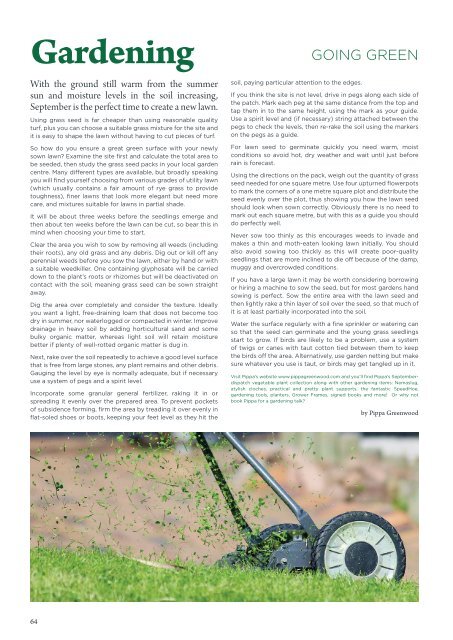I and A Mag Sep19
Telford Magazine
Telford Magazine
You also want an ePaper? Increase the reach of your titles
YUMPU automatically turns print PDFs into web optimized ePapers that Google loves.
Gardening<br />
With the ground still warm from the summer<br />
sun <strong>and</strong> moisture levels in the soil increasing,<br />
September is the perfect time to create a new lawn.<br />
Using grass seed is far cheaper than using reasonable quality<br />
turf, plus you can choose a suitable grass mixture for the site <strong>and</strong><br />
it is easy to shape the lawn without having to cut pieces of turf.<br />
So how do you ensure a great green surface with your newly<br />
sown lawn? Examine the site first <strong>and</strong> calculate the total area to<br />
be seeded, then study the grass seed packs in your local garden<br />
centre. Many different types are available, but broadly speaking<br />
you will find yourself choosing from various grades of utility lawn<br />
(which usually contains a fair amount of rye grass to provide<br />
toughness), finer lawns that look more elegant but need more<br />
care, <strong>and</strong> mixtures suitable for lawns in partial shade.<br />
It will be about three weeks before the seedlings emerge <strong>and</strong><br />
then about ten weeks before the lawn can be cut, so bear this in<br />
mind when choosing your time to start.<br />
Clear the area you wish to sow by removing all weeds (including<br />
their roots), any old grass <strong>and</strong> any debris. Dig out or kill off any<br />
perennial weeds before you sow the lawn, either by h<strong>and</strong> or with<br />
a suitable weedkiller. One containing glyphosate will be carried<br />
down to the plant’s roots or rhizomes but will be deactivated on<br />
contact with the soil, meaning grass seed can be sown straight<br />
away.<br />
Dig the area over completely <strong>and</strong> consider the texture. Ideally<br />
you want a light, free-draining loam that does not become too<br />
dry in summer, nor waterlogged or compacted in winter. Improve<br />
drainage in heavy soil by adding horticultural s<strong>and</strong> <strong>and</strong> some<br />
bulky organic matter, whereas light soil will retain moisture<br />
better if plenty of well-rotted organic matter is dug in.<br />
Next, rake over the soil repeatedly to achieve a good level surface<br />
that is free from large stones, any plant remains <strong>and</strong> other debris.<br />
Gauging the level by eye is normally adequate, but if necessary<br />
use a system of pegs <strong>and</strong> a spirit level.<br />
Incorporate some granular general fertilizer, raking it in or<br />
spreading it evenly over the prepared area. To prevent pockets<br />
of subsidence forming, firm the area by treading it over evenly in<br />
flat-soled shoes or boots, keeping your feet level as they hit the<br />
soil, paying particular attention to the edges.<br />
GOING GREEN<br />
If you think the site is not level, drive in pegs along each side of<br />
the patch. Mark each peg at the same distance from the top <strong>and</strong><br />
tap them in to the same height, using the mark as your guide.<br />
Use a spirit level <strong>and</strong> (if necessary) string attached between the<br />
pegs to check the levels, then re-rake the soil using the markers<br />
on the pegs as a guide.<br />
For lawn seed to germinate quickly you need warm, moist<br />
conditions so avoid hot, dry weather <strong>and</strong> wait until just before<br />
rain is forecast.<br />
Using the directions on the pack, weigh out the quantity of grass<br />
seed needed for one square metre. Use four upturned flowerpots<br />
to mark the corners of a one metre square plot <strong>and</strong> distribute the<br />
seed evenly over the plot, thus showing you how the lawn seed<br />
should look when sown correctly. Obviously there is no need to<br />
mark out each square metre, but with this as a guide you should<br />
do perfectly well.<br />
Never sow too thinly as this encourages weeds to invade <strong>and</strong><br />
makes a thin <strong>and</strong> moth-eaten looking lawn initially. You should<br />
also avoid sowing too thickly as this will create poor-quality<br />
seedlings that are more inclined to die off because of the damp,<br />
muggy <strong>and</strong> overcrowded conditions.<br />
If you have a large lawn it may be worth considering borrowing<br />
or hiring a machine to sow the seed, but for most gardens h<strong>and</strong><br />
sowing is perfect. Sow the entire area with the lawn seed <strong>and</strong><br />
then lightly rake a thin layer of soil over the seed, so that much of<br />
it is at least partially incorporated into the soil.<br />
Water the surface regularly with a fine sprinkler or watering can<br />
so that the seed can germinate <strong>and</strong> the young grass seedlings<br />
start to grow. If birds are likely to be a problem, use a system<br />
of twigs or canes with taut cotton tied between them to keep<br />
the birds off the area. Alternatively, use garden netting but make<br />
sure whatever you use is taut, or birds may get tangled up in it.<br />
Visit Pippa’s website www.pippagreenwood.com <strong>and</strong> you’ll find Pippa’s Septemberdispatch<br />
vegetable plant collection along with other gardening items: Nemaslug,<br />
atylish cloches, practical <strong>and</strong> pretty plant supports, the fantastic SpeedHoe,<br />
gardening tools, planters, Grower Frames, signed books <strong>and</strong> more! Or why not<br />
book Pippa for a gardening talk?<br />
by Pippa Greenwood<br />
64










